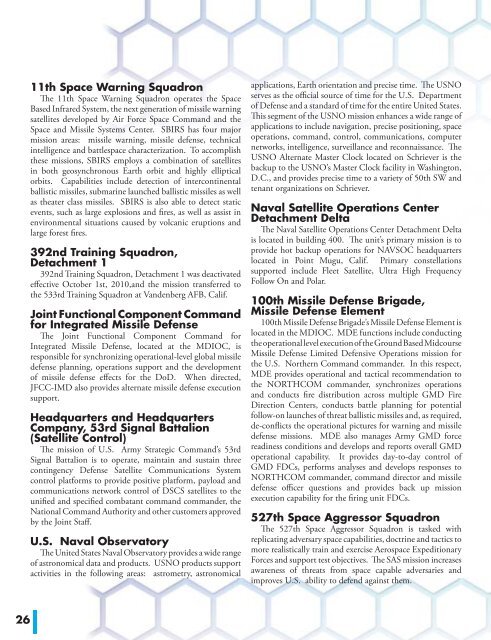310TH SPACE WING (AFRC) (310 SW) - Schriever Air Force Base
310TH SPACE WING (AFRC) (310 SW) - Schriever Air Force Base
310TH SPACE WING (AFRC) (310 SW) - Schriever Air Force Base
Create successful ePaper yourself
Turn your PDF publications into a flip-book with our unique Google optimized e-Paper software.
26<br />
11th Space Warning Squadron<br />
Th e 11th Space Warning Squadron operates the Space<br />
<strong>Base</strong>d Infrared System, the next generation of missile warning<br />
satellites developed by <strong>Air</strong> <strong>Force</strong> Space Command and the<br />
Space and Missile Systems Center. SBIRS has four major<br />
mission areas: missile warning, missile defense, technical<br />
intelligence and battlespace characterization. To accomplish<br />
these missions, SBIRS employs a combination of satellites<br />
in both geosynchronous Earth orbit and highly elliptical<br />
orbits. Capabilities include detection of intercontinental<br />
ballistic missiles, submarine launched ballistic missiles as well<br />
as theater class missiles. SBIRS is also able to detect static<br />
events, such as large explosions and fi res, as well as assist in<br />
environmental situations caused by volcanic eruptions and<br />
large forest fi res.<br />
392nd Training Squadron,<br />
Detachment 1<br />
392nd Training Squadron, Detachment 1 was deactivated<br />
eff ective October 1st, 2010,and the mission transferred to<br />
the 533rd Training Squadron at Vandenberg AFB, Calif.<br />
Joint Functional Component Command<br />
for Integrated Missile Defense<br />
Th e Joint Functional Component Command for<br />
Integrated Missile Defense, located at the MDIOC, is<br />
responsible for synchronizing operational-level global missile<br />
defense planning, operations support and the development<br />
of missile defense eff ects for the DoD. When directed,<br />
JFCC-IMD also provides alternate missile defense execution<br />
support.<br />
Headquarters and Headquarters<br />
Company, 53rd Signal Battalion<br />
(Satellite Control)<br />
Th e mission of U.S. Army Strategic Command’s 53rd<br />
Signal Battalion is to operate, maintain and sustain three<br />
contingency Defense Satellite Communications System<br />
control platforms to provide positive platform, payload and<br />
communications network control of DSCS satellites to the<br />
unifi ed and specifi ed combatant command commander, the<br />
National Command Authority and other customers approved<br />
by the Joint Staff .<br />
U.S. Naval Observatory<br />
Th e United States Naval Observatory provides a wide range<br />
of astronomical data and products. USNO products support<br />
activities in the following areas: astrometry, astronomical<br />
applications, Earth orientation and precise time. Th e USNO<br />
serves as the offi cial source of time for the U.S. Department<br />
of Defense and a standard of time for the entire United States.<br />
Th is segment of the USNO mission enhances a wide range of<br />
applications to include navigation, precise positioning, space<br />
operations, command, control, communications, computer<br />
networks, intelligence, surveillance and reconnaissance. Th e<br />
USNO Alternate Master Clock located on <strong>Schriever</strong> is the<br />
backup to the USNO’s Master Clock facility in Washington,<br />
D.C., and provides precise time to a variety of 50th <strong>SW</strong> and<br />
tenant organizations on <strong>Schriever</strong>.<br />
Naval Satellite Operations Center<br />
Detachment Delta<br />
Th e Naval Satellite Operations Center Detachment Delta<br />
is located in building 400. Th e unit’s primary mission is to<br />
provide hot backup operations for NAVSOC headquarters<br />
located in Point Mugu, Calif. Primary constellations<br />
supported include Fleet Satellite, Ultra High Frequency<br />
Follow On and Polar.<br />
100th Missile Defense Brigade,<br />
Missile Defense Element<br />
100th Missile Defense Brigade’s Missile Defense Element is<br />
located in the MDIOC. MDE functions include conducting<br />
the operational level execution of the Ground <strong>Base</strong>d Midcourse<br />
Missile Defense Limited Defensive Operations mission for<br />
the U.S. Northern Command commander. In this respect,<br />
MDE provides operational and tactical recommendation to<br />
the NORTHCOM commander, synchronizes operations<br />
and conducts fi re distribution across multiple GMD Fire<br />
Direction Centers, conducts battle planning for potential<br />
follow-on launches of threat ballistic missiles and, as required,<br />
de-confl icts the operational pictures for warning and missile<br />
defense missions. MDE also manages Army GMD force<br />
readiness conditions and develops and reports overall GMD<br />
operational capability. It provides day-to-day control of<br />
GMD FDCs, performs analyses and develops responses to<br />
NORTHCOM commander, command director and missile<br />
defense offi cer questions and provides back up mission<br />
execution capability for the fi ring unit FDCs.<br />
527th Space Aggressor Squadron<br />
Th e 527th Space Aggressor Squadron is tasked with<br />
replicating adversary space capabilities, doctrine and tactics to<br />
more realistically train and exercise Aerospace Expeditionary<br />
<strong>Force</strong>s and support test objectives. Th e SAS mission increases<br />
awareness of threats from space capable adversaries and<br />
improves U.S. ability to defend against them.<br />
©2012 Benchmark Publications, Inc.














